An Ultra-Precision Smoothing Polishing Model for Optical Surface Fabrication with Morphology Gradient Awareness
Abstract
1. Introduction
- (a)
- A novel smoothing framework that integrates surface morphology characteristics—specifically, surface gradient and curvature—into the control of dwell time, enabling topology-aware polishing strategies;
- (b)
- A spatiotemporal nonlinear control model is established, where dwell time modulation is dynamically coupled with surface feature evolution and periodic process perturbations.
2. Theoretical Foundations of Morphology Gradient-Aware Smoothing
2.1. Fundamental Principles of Smoothing and Material Removal
2.2. Morphology Gradient Aware Spatiotemporal Coupled Model
2.2.1. Instantaneous Material Removal Modeling Driven by Surface Topography
2.2.2. Modeling Framework Based on Surface Morphology Gradient
3. Simulation for Model Validation
4. Experimental Validation
4.1. Experimental Setup
4.2. Results Analysis
- (1)
- Surface Error Evolution Before and After Smoothing.
- (2)
- Quantitative Evaluation of PV and RMS Indicators
- (3)
- Frequency Domain Analysis via PSD Curves
5. Conclusions
- (1)
- A gradient- and curvature-driven modulation mechanism was established, enabling dynamic and region-specific dwell-time adjustment based on local surface morphology.
- (2)
- The proposed model effectively reduces PV and RMS errors while achieving superior suppression of MSF features, as evidenced by significant improvements in PSD curve behavior.
- (3)
- Compared to traditional uniform smoothing, the proposed approach demonstrates higher convergence rates, thereby enhancing final surface quality.
Author Contributions
Funding
Data Availability Statement
Acknowledgments
Conflicts of Interest
References
- Deng, Y.; Hou, X.; Li, B.; Wang, J.; Zhang, Y. Review on mid-spatial frequency error suppression in optical components manufacturing. Int. J. Adv. Manuf. Technol. 2023, 126, 4827–4847. [Google Scholar] [CrossRef]
- Deng, Y.; Hou, X.; Li, B.; Wang, J.; Zhang, Y. A highly powerful calibration method for robotic smoothing system calibration via using adaptive residual extended Kalman filter. Rob. Comput.-Integr. Manuf. 2024, 86, 102660. [Google Scholar] [CrossRef]
- Brown, N.J.; Baker, P.C.; Parks, R.E. Polishing-to-figuring transition in turned optics. In Contemporary Methods of Optical Fabrication. Proceedings of the 25th Annual Technical Symposium, San Diego, CA, USA, 25–26 August 1981; SPIE: Bellingham, WA, USA, 1982; Volume 306, pp. 58–65. [Google Scholar]
- Jones, R.A. Computer simulation of smoothing during computer-controlled optical polishing. Appl. Opt. 1995, 34, 1162–1169. [Google Scholar] [CrossRef] [PubMed]
- Mehta, P.K.; Reid, P.B. Mathematical model for optical smoothing prediction of high-spatial-frequency surface error. In Optomechanical Engineering and Vibration Control. Proceedings of the SPIE's International Symposium on Optical Science, Engineering, and Instrumentation, Denver, CO, USA, 20–23 July 1999; SPIE: Bellingham, WA, USA, 1999; Volume 3786, pp. 447–459. [Google Scholar]
- Tuell, M.T.; Burge, J.H.; Anderson, B. Aspheric optics: Smoothing the ripples with semi-flexible tools. Opt. Eng. 2002, 41, 1473–1474. [Google Scholar] [CrossRef]
- Kim, D.W.; Park, W.H.; An, H.K.; Burge, J.H. Parametric smoothing model for visco-elastic polishing tools. Opt. Express 2010, 18, 22515–22526. [Google Scholar] [CrossRef] [PubMed]
- Shu, Y.; Kim, D.W.; Martin, H.M.; Burge, J.H. Correlation-based smoothing model for optical polishing. Opt. Express 2013, 21, 28771–28782. [Google Scholar] [CrossRef] [PubMed]
- Nie, X.; Li, S.; Shi, F.; Hu, H. Generalized numerical pressure distribution model for smoothing polishing of irregular midspatial frequency error. Appl. Opt. 2014, 53, 1020–1027. [Google Scholar] [CrossRef] [PubMed]
- Zhang, Y.; Wei, C.; Shao, J.; Xu, X.; Liu, S.; Hu, C.; Gu, H. Correction of mid-spatial-frequency error by smoothing in spin motion for CCOS. In Optical Manufacturing and Testing XI. Proceedings of the SPIE Optical Engineering + Applications, San Diego, CA, USA, 9–11 August 2015; SPIE: Bellingham, WA, USA, 2015; Volume 9575, pp. 67–73. [Google Scholar]
- Kim, D.W.; Burge, J.H. Rigid conformal polishing tool using non-linear visco-elastic effect. Opt. Express 2010, 18, 2242–2257. [Google Scholar] [CrossRef] [PubMed]
- Nie, X.; Li, S.; Hu, H.; Li, Q. Control of mid-spatial frequency error considering the pad groove feature in smoothing polishing process. Appl. Opt. 2014, 53, 6332–6339. [Google Scholar] [CrossRef] [PubMed]
- Wang, T.; Ke, X.; Huang, L.; Cui, Q.; Zhang, Z.; Wang, C.; Kang, H.; Pullen, W.; Choi, H.; Kim, D.; et al. A comprehensive review of dwell time optimization methods in computer-controlled optical surfacing. Light Adv. Manuf. 2024, 5, 422–451. [Google Scholar] [CrossRef]
- Jones, R.A.; Rupp, W.J. Rapid optical fabrication with computer-controlled optical surfacing. Opt. Eng. 1991, 30, 1962–1968. [Google Scholar] [CrossRef]
- Beaucamp, A.; Takizawa, K.; Han, Y.; Zhu, W. Reduction of mid-spatial frequency errors on aspheric and freeform optics by circular-random path polishing. Opt. Express 2021, 29, 29802–29812. [Google Scholar] [CrossRef] [PubMed]
- He, Z.; Hai, K.; Li, K.; Yu, J.; Wu, L.; Zhang, L.; Hang, W. Research on the Influence of the Material Removal Profile of a Spherical Polishing Tool on the Mid-Spatial Frequency Errors of Optical Surfaces. Micromachines 2024, 15, 654. [Google Scholar] [CrossRef] [PubMed]
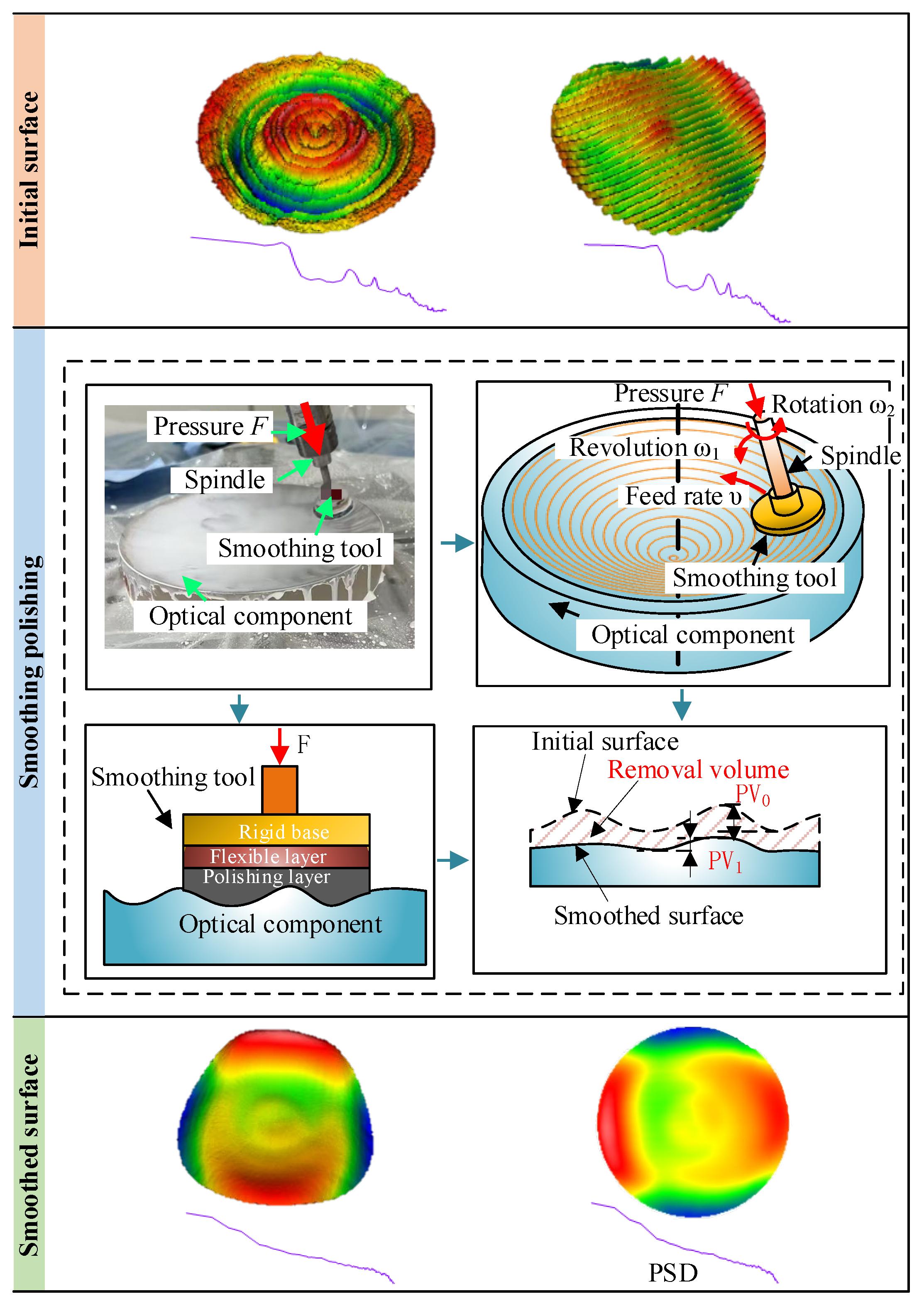
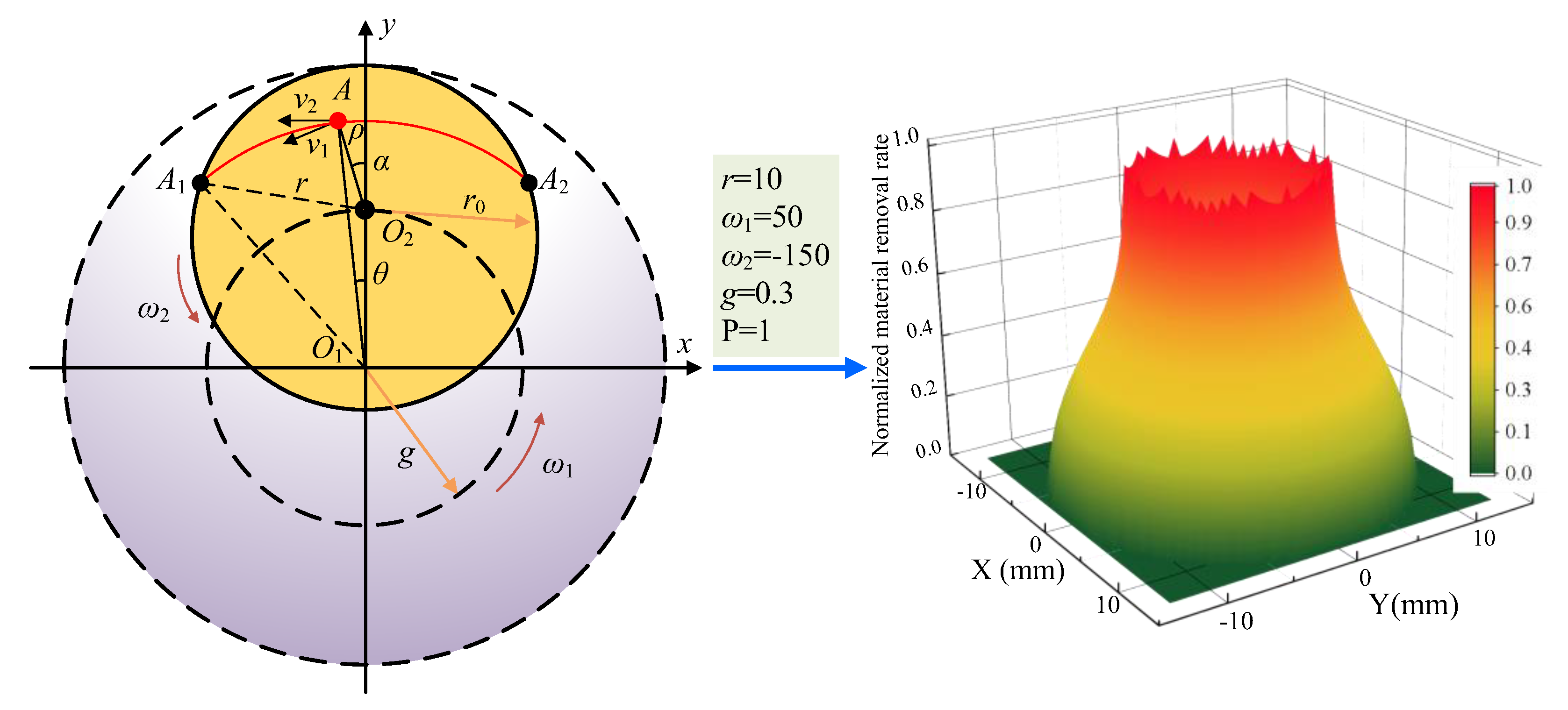
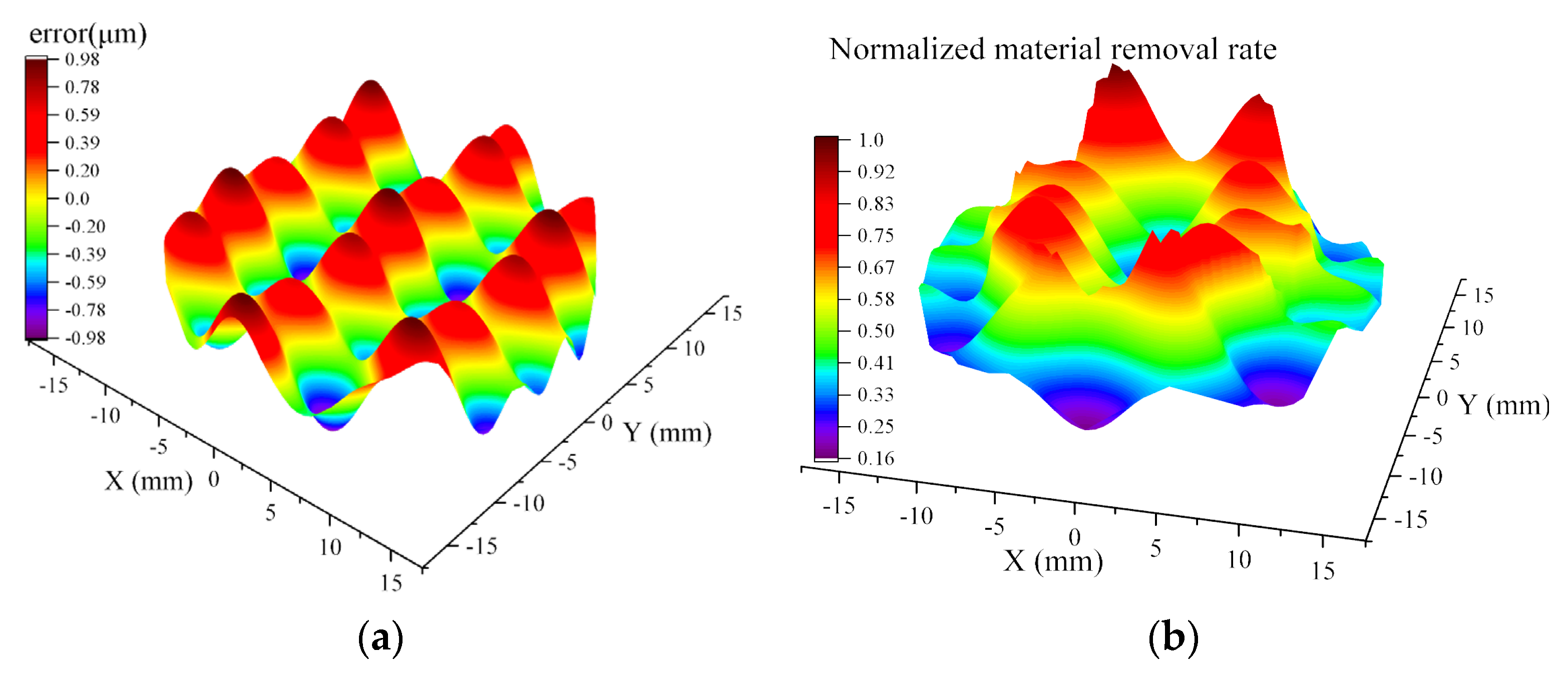

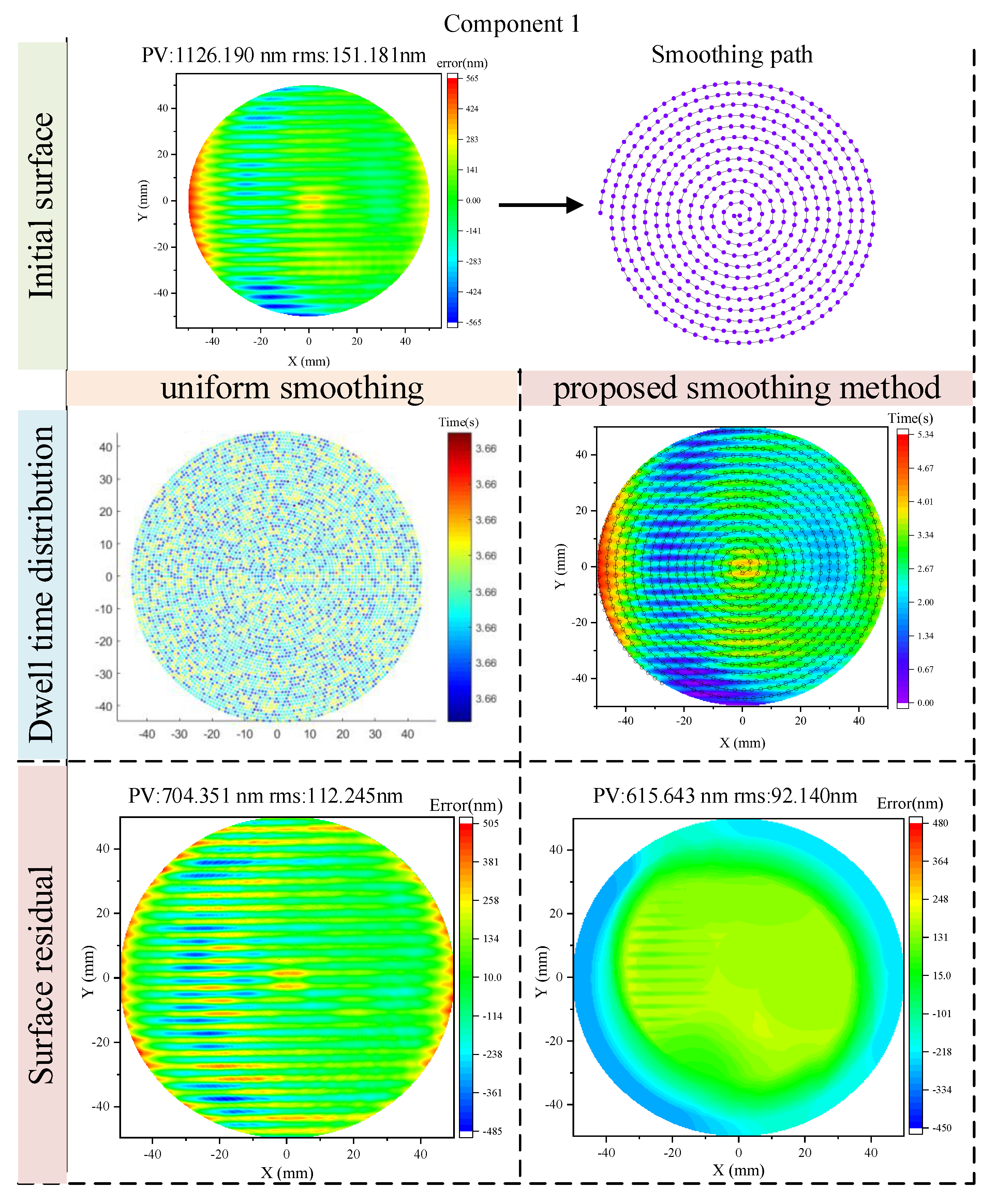


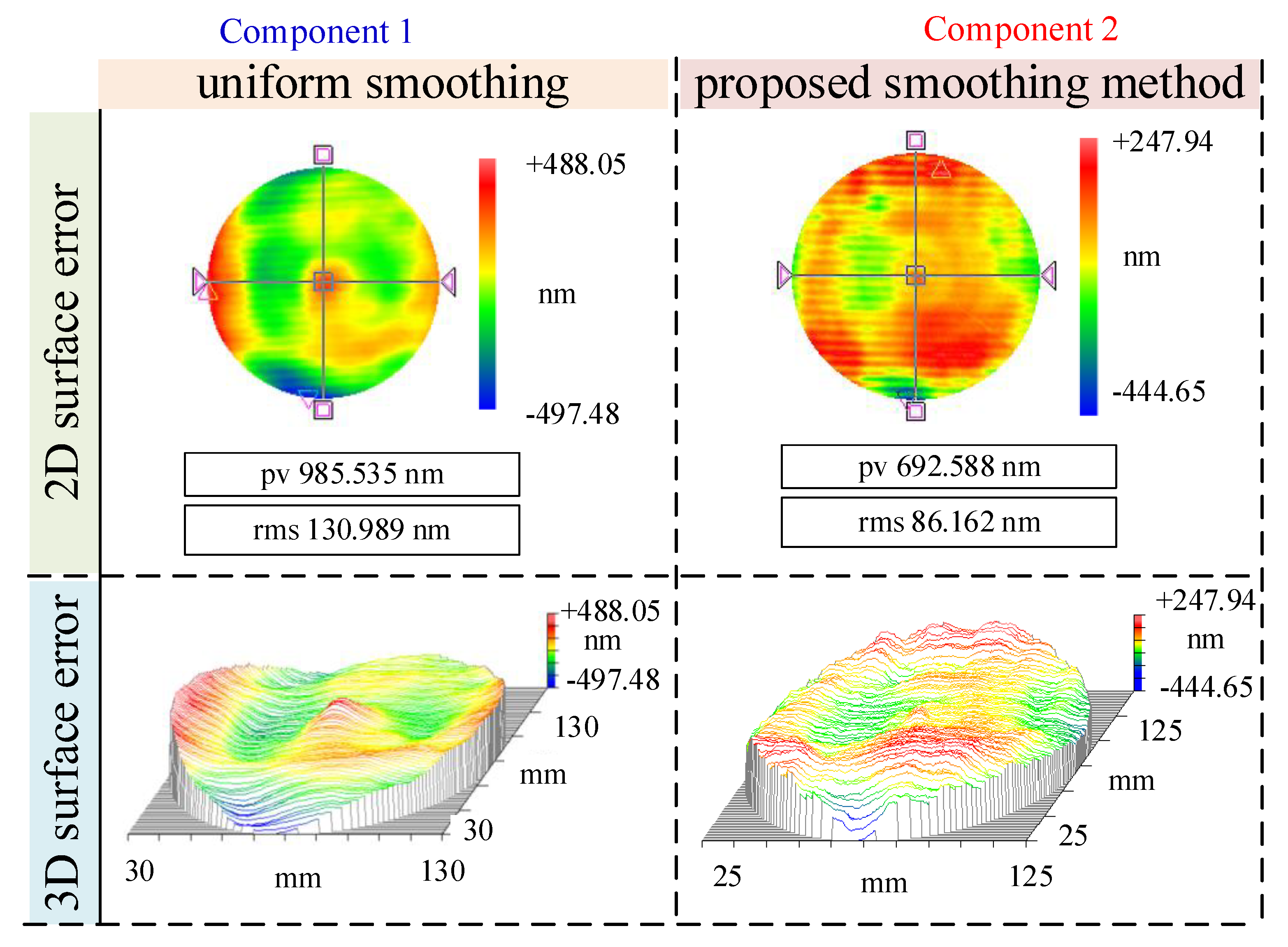


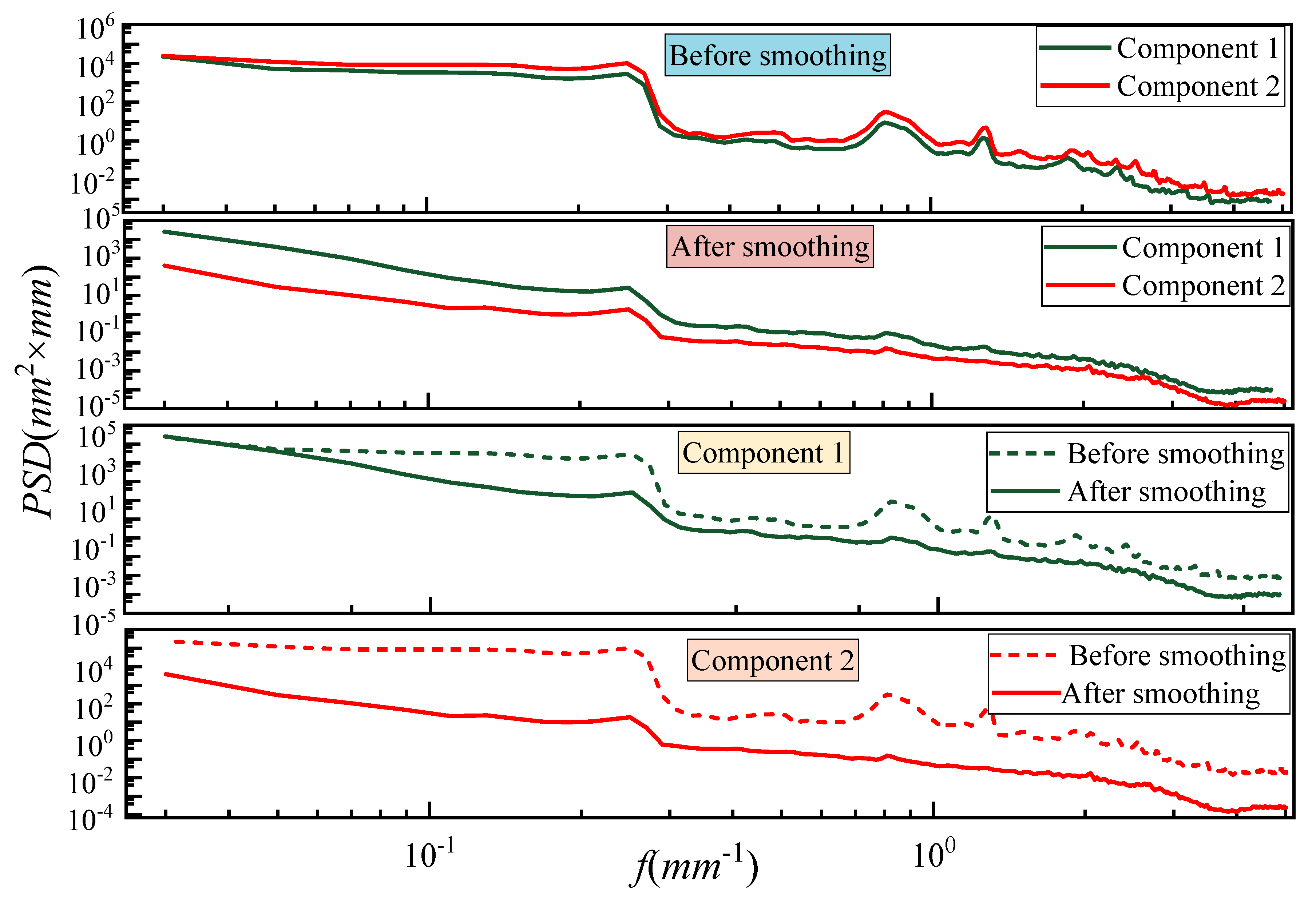
| Experimental Item | Specification |
|---|---|
| Robot system | Stäubli TX200 |
| Component properties | Φ140 mm Fused silica |
| Smoothing tool | pitch pad |
| Polishing path | spiral path |
| Line spacing/point spacing | 1/1 (mm) |
| Ambient temperature | 25 °C |
| Rotation/revolution | 120/100 (r/min) |
| Smooth pressure | 15 (N) |
| Slurry | CeO2 (0.5 μm) (free concentration, flow maintained) |
Disclaimer/Publisher’s Note: The statements, opinions and data contained in all publications are solely those of the individual author(s) and contributor(s) and not of MDPI and/or the editor(s). MDPI and/or the editor(s) disclaim responsibility for any injury to people or property resulting from any ideas, methods, instructions or products referred to in the content. |
© 2025 by the authors. Licensee MDPI, Basel, Switzerland. This article is an open access article distributed under the terms and conditions of the Creative Commons Attribution (CC BY) license (https://creativecommons.org/licenses/by/4.0/).
Share and Cite
Liu, G.; Deng, Y.; Li, Z. An Ultra-Precision Smoothing Polishing Model for Optical Surface Fabrication with Morphology Gradient Awareness. Micromachines 2025, 16, 734. https://doi.org/10.3390/mi16070734
Liu G, Deng Y, Li Z. An Ultra-Precision Smoothing Polishing Model for Optical Surface Fabrication with Morphology Gradient Awareness. Micromachines. 2025; 16(7):734. https://doi.org/10.3390/mi16070734
Chicago/Turabian StyleLiu, Guohao, Yonghong Deng, and Zhibin Li. 2025. "An Ultra-Precision Smoothing Polishing Model for Optical Surface Fabrication with Morphology Gradient Awareness" Micromachines 16, no. 7: 734. https://doi.org/10.3390/mi16070734
APA StyleLiu, G., Deng, Y., & Li, Z. (2025). An Ultra-Precision Smoothing Polishing Model for Optical Surface Fabrication with Morphology Gradient Awareness. Micromachines, 16(7), 734. https://doi.org/10.3390/mi16070734






